Arkansas, a state known for its stunning landscapes and diverse wildlife, is also home to an array of fascinating bird species. One of the most enchanting times to observe these avian creatures is during the winter months.
As the bitter cold settles in and snow blankets the ground, the presence of winter birds becomes even more remarkable in this southern state.
From graceful waterfowl gliding across frozen lakes to small songbirds braving the chilly winds, Arkansas offers a unique opportunity to witness the resilience and beauty of winter birds in their natural habitat.
In this article, we will explore some of the notable winter birds that grace Arkansas with their presence and delve into the exceptional adaptations that allow them to thrive in such harsh conditions.
Let us embark on a journey through Arkansas’s winter landscapes, discovering these feathered visitors’ charm and wonder.
45 Winter Birds in Arkansas
Whether you’re an avid birdwatcher or just curious about the feathered visitors in your backyard, Arkansas offers a diverse array of winter birds to observe. Let’s explore some of these fascinating species.
Here are 45 Amazing Winter Birds in Arkansas.
1. Northern Cardinal
The northern cardinal is a type of bird commonly referred to by different names, such as redbird, common cardinal, red cardinal, or simply cardinal.
It belongs to the genus Cardinalis. The cardinal is primarily found in North America, particularly in regions such as the United States, Canada, and Mexico. It is known for its vibrant red plumage, which is more prominent in males than females.
The male cardinal has a distinctive crest on its head, while the female has a reddish tinge on its feathers. These birds are often observed in various habitats, including woodlands, gardens, and urban areas.
They adapt to different environments and thrive in rural and suburban settings.
Cardinals are also known for their beautiful songs, which are melodic and often used for communication and territorial marking. In terms of diet, the cardinal is omnivorous, meaning it eats various foods.
Its diet comprises seeds, fruits, insects, and occasionally small reptiles or amphibians.
They have a strong beak that allows them to easily crack open seeds and fruits. Cardinals engage in courtship rituals during the breeding season, which typically occurs in spring and early summer. The male cardinal displays its vibrant red plum.
| Kingdom | Animalia |
| Phylum | Chordata |
| Clade | Dinosauria |
| Class | Aves |
| Order | Passeriformes |
| Family | Cardinalidae |
| Genus | Cardinalis |
| Species | C. cardinalis |
2. Downy Woodpecker
The downy woodpecker is a type of bird known as a woodpecker. It is the smallest species of woodpecker found in North America. Its size can range from 14 to 18 centimeters. These woodpeckers can be found in various forested areas across the United States and Canada.
However, they are not commonly seen in desert regions in the southwest or the northern tundra. Due to their small size, downy woodpeckers are well-adapted to living in forested environments.
They can navigate through the trees and search for food more quickly than larger woodpecker species. One exciting feature of the downy woodpecker is its ability to drum on trees.
This drumming serves multiple purposes, including communication with other woodpeckers and marking its territory. The diet of the downy woodpecker primarily consists of insects and larvae found within the trees.
They use their strong beaks to peck at the bark and wood, uncovering their prey. These woodpeckers are known for their distinct black and white plumage. They have a white belly and back, with black wings and a black head. This coloration helps them blend in with the tree.
| Kingdom | Animalia |
| Phylum | Chordata |
| Clade | Dinosauria |
| Class | Aves |
| Order | Piciformes |
| Family | Picidae |
| Genus | Dryobates |
| Species | D. pubescens |
3. American Goldfinch
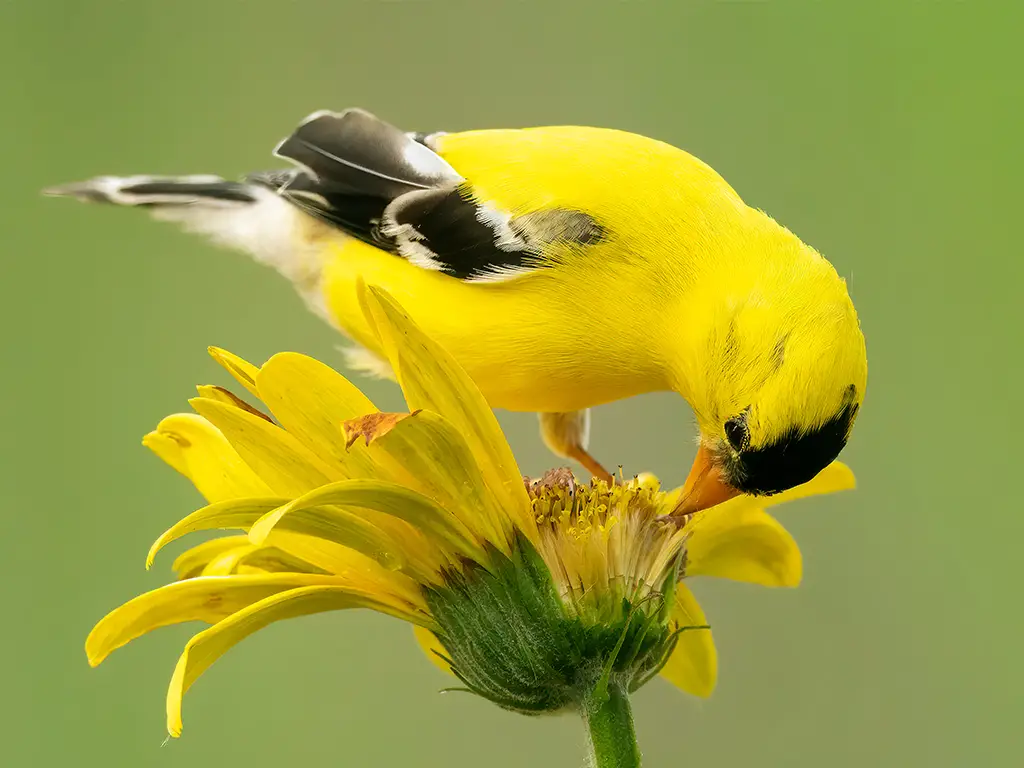
The American goldfinch is a type of bird that is found in North America.
It belongs to the finch family, a group of small birds known for their colorful feathers and pleasant songs. This bird is migratory, meaning it travels from one place to another depending on the time of year.
During the breeding season, when they mate and lay eggs, the American goldfinch can be found in areas ranging from mid-Alberta in Canada to North Carolina in the United States. When the weather gets colder in the winter, the American goldfinch migrates to a different region.
They move from just south of the Canada–United States border and travel down to Mexico.
This helps them find better conditions for survival as the temperature and food availability change with the seasons. The reason for their migration is mainly related to the availability of food.
During the breeding season, the American goldfinch feeds on insects and seeds from plants like sunflowers and thistles.
These food sources are abundant in the areas where they breed, providing them with the necessary nutrients for reproduction and raising their young. However, these insects and plants may not be readily available in their breeding grounds during the winter.
| Kingdom | Animalia |
| Phylum | Chordata |
| Clade | Dinosauria |
| Class | Aves |
| Order | Passeriformes |
| Family | Fringillidae |
| Genus | Spinus |
| Species | S. tristis |
4. Mourning Dove
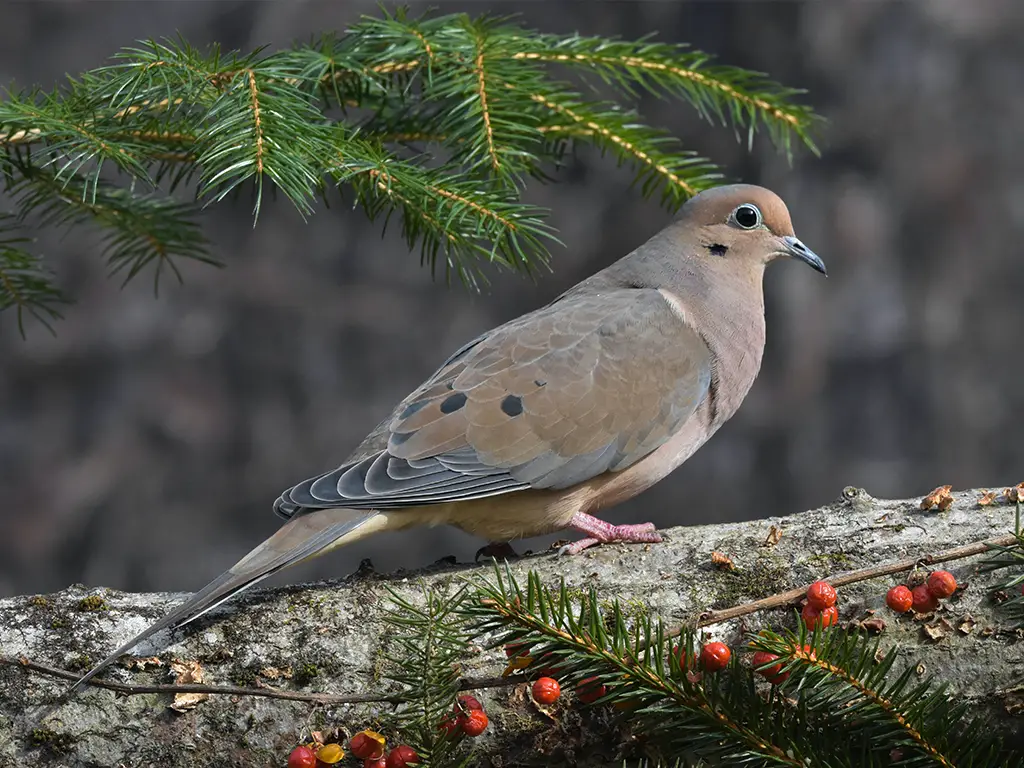
The mourning dove is a type of bird that belongs to the dove family called Columbidae. This bird is also known by different names, such as the American mourning dove, the rain dove, colloquially the,e turtle dove.
In the past, it was referred to as the Carolina pigeon and Carolina turtledove. The mourning dove is a common species found in North and Central America. It is recognized for its soft, mournful cooing sound, which gives it its name.
This bird is known for its slender body and long, pointed tail. It has a grayish-brown color with lighter shades on its underparts. One interesting fact about mourning doves is their ability to adapt to various habitats.
They can be found in different environments like forests, fields, urban areas, and deserts. They are known to thrive in both rural and suburban settings. Mourning doves primarily feed on seeds, grains, and fruits.
They have a unique diet as they can swallow seeds whole and store them in their crop, a specialized part of their digestive system. This allows them to eat in one location and then retreat to a safer place to digest their food. These birds are monogamous, meaning they mate.
| Kingdom | Animalia |
| Phylum | Chordata |
| Clade | Dinosauria |
| Class | Aves |
| Order | Columbiformes |
| Family | Columbidae |
| Genus | Zenaida |
| Species | Z. macroura |
5. Tufted Titmouse
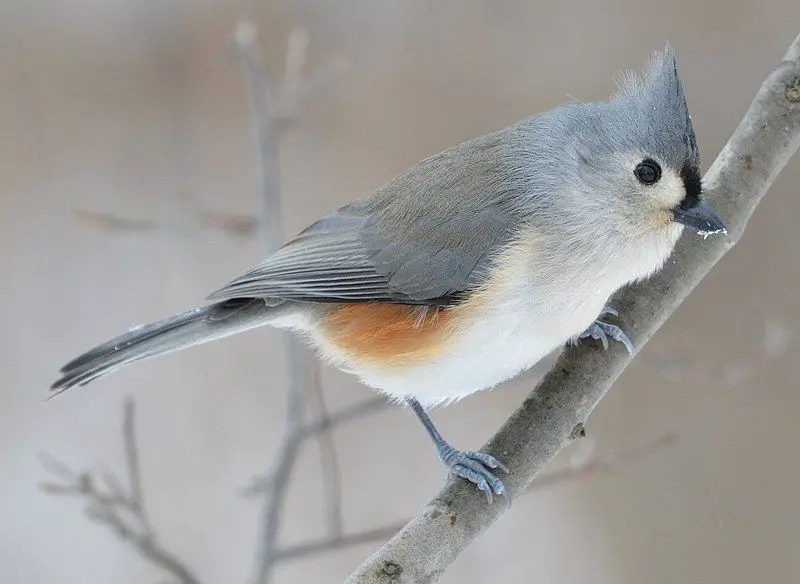
The tufted titmouse is a little bird found in North America. It belongs to the tit and chickadee family, which means it is closely related to other birds in that family.
In the past, another bird called the black-crested titmouse was thought to be a subspecies of the tufted titmouse. This means they were very similar in appearance and behavior but slightly different.
However, scientists have now determined that the black-crested titmouse is a separate species. It is officially called Baeolophus atricristatus. The black-crested titmouse is found in central and southern Texas, extending southward from there.
This means it can also be seen in areas further south from Texas. This separation of the black-crested titmouse from the tufted titmouse is an essential distinction in the scientific world.
It helps us understand the diversity of bird species and how they are related. Learning about these small songbirds and the distinctions between different species is fascinating.
Scientists can gain valuable insights into the natural world and the incredible by studying and understanding these differences.
| Kingdom | Animalia |
| Phylum | Chordata |
| Clade | Dinosauria |
| Class | Aves |
| Order | Passeriformes |
| Family | Paridae |
| Genus | Baeolophus |
| Species | B. bicolor |
6. American Robin
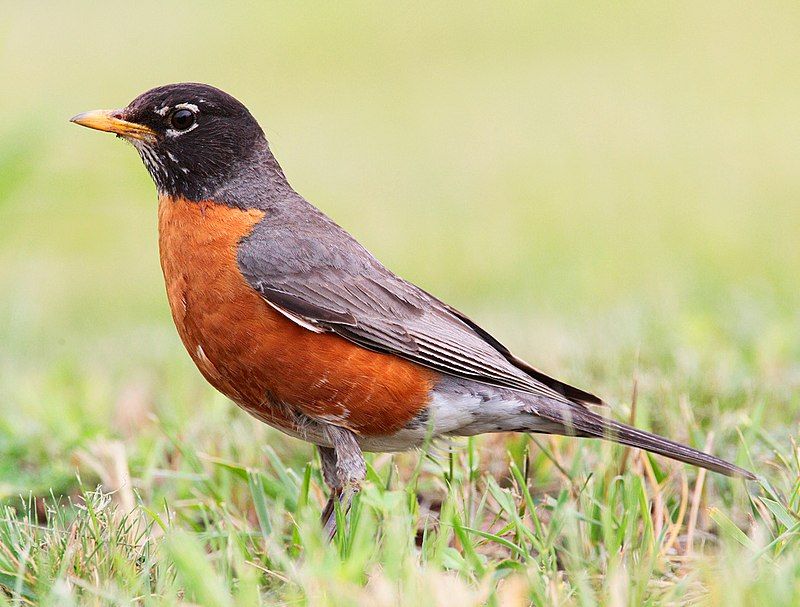
The American robin is a type of bird that migrates. It belongs to the valid thrush genus and the Turdidae family, a more prominent thrush family. It gets its name from the European robin because of its reddish-orange breast.
However, it is essential to note that the American and European robin are not closely related. The European robin is a different species and belongs to the Old World flycatcher family.
Despite their similar names and physical characteristics, these two birds are not closely related regarding their genetic makeup.
They may share some similarities in appearance, such as the reddish-orange breast, but their evolutionary paths have taken them in different directions. The American robin is primarily found in North America, while the European robin is native to Europe and parts of Asia.
Both species have adapted to their respective environments and habitats over time.
The American robin is known for its ability to migrate long distances, often traveling south during winter and returning north for breeding season. Regarding physical characteristics, the American robin is larger than the European robin.
It has a grayish-brown back and a distinct reddish-orange breast, a defining feature of the species.
| Kingdom | Animalia |
| Phylum | Chordata |
| Clade | Dinosauria |
| Class | Aves |
| Order | Passeriformes |
| Family | Turdidae |
| Genus | Turdus |
| Species | T. migratorius |
7. House Finch
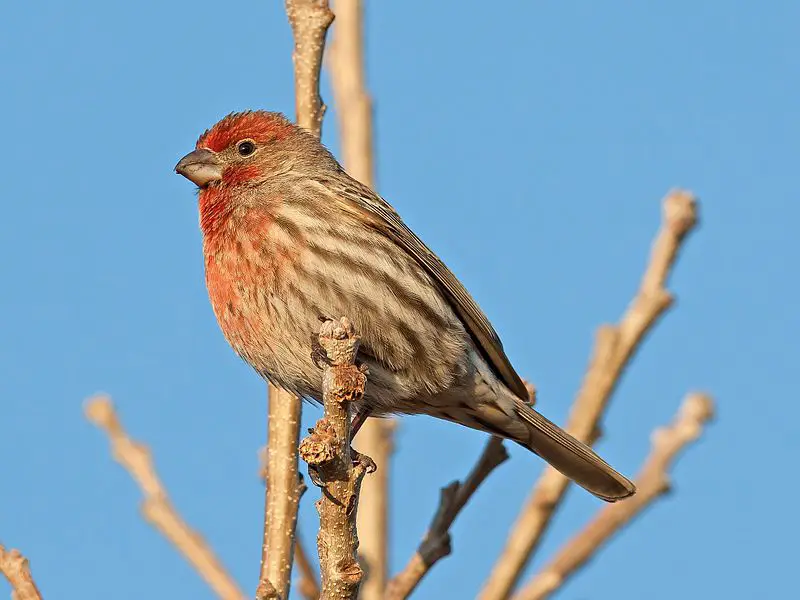
The house finch is a type of bird that belongs to the finch family called Fringillidae. This bird is originally from western North America.
However, it has also been introduced to other parts of the continent, such as the eastern half and Hawaii. The house finch is not the only bird in its genus.
It is grouped with two other American rosefinches, and all three are placed in the genus Haemorhous. The house finch is known for its beautiful red coloration, especially in males. The males have a reddish hue on their heads, chests, and backs.
Females, on the other hand, have more muted colors with brownish feathers. These birds are relatively small, measuring about 12 to 16 centimeters in length. They have short wings and a slightly notched tail.
Their beaks are conical in shape and designed for cracking open seeds, which are their primary food source. House finches are highly adaptable and can be found in various habitats, including urban areas, forests, and grasslands.
They are known for their melodic songs, which they use to communicate and attract mates. Breeding season for these.
| Kingdom | Animalia |
| Phylum | Chordata |
| Clade | Dinosauria |
| Class | Aves |
| Order | Passeriformes |
| Family | Fringillidae |
| Genus | Haemorhous |
| Species | H. mexicanus |
8. Red-bellied woodpecker
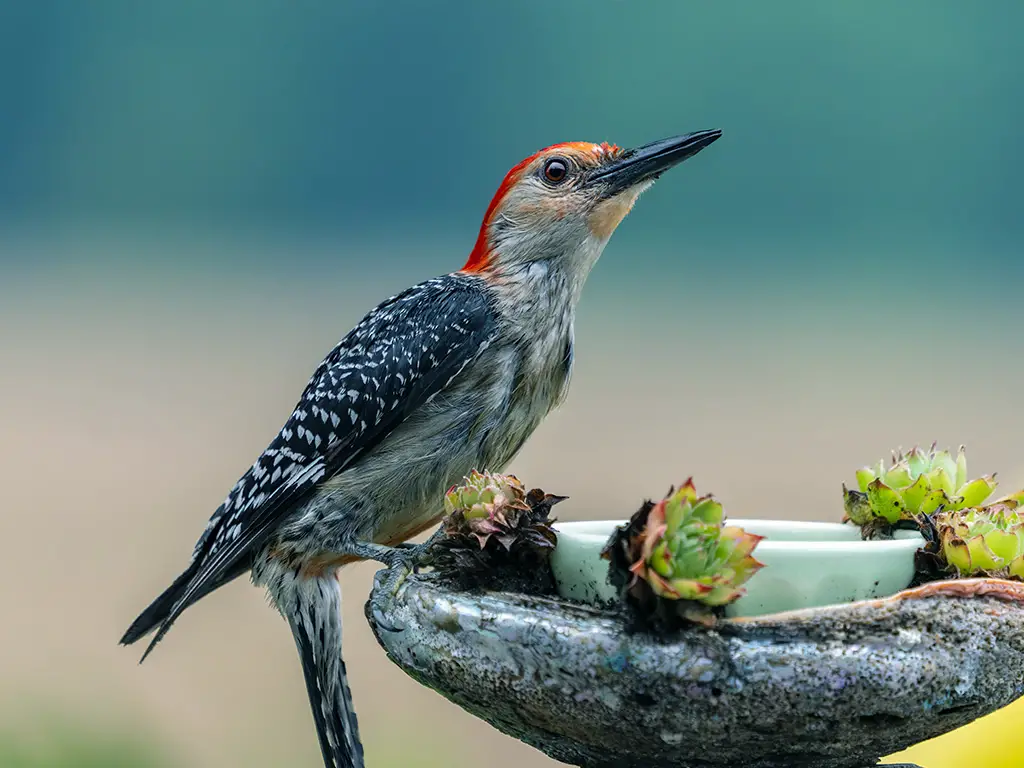
The red-bellied woodpecker is a bird that belongs to the family Picidae. It is not too big or too small; it is considered a medium-sized woodpecker.
This means it is smaller than some other woodpecker species but larger than others. These woodpeckers are found primarily in the eastern part of the United States. However, they can also be seen in other areas.
They have a wide range, stretching from as far south as Florida to as far north as Canada. This means that they can be found in many different states and provinces within these regions. Regarding their appearance, the red-bellied woodpecker has some distinct features.
As the name suggests, they have a red belly, although this may not be immediately noticeable. Their belly is more of a pale or dull red color compared to other parts of their body.
They also have a red cap on the top of their head, which is more vibrant and noticeable. In addition to their red belly and cap, these woodpeckers have a black and white pattern on their back, wings, and tail.
The black feathers provide a nice contrast against the white feathers, creating a visual.
| Kingdom | Animalia |
| Phylum | Chordata |
| Clade | Dinosauria |
| Class | Aves |
| Order | Piciformes |
| Family | Picidae |
| Genus | Melanerpes |
| Species | M. carolinus |
9. Dark-Eyed Junco
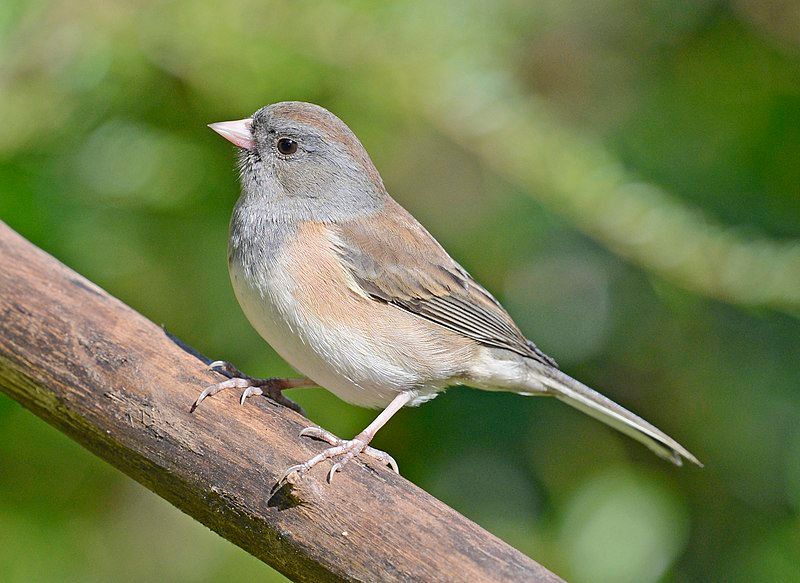
The dark-eyed junco is a type of bird called a junco. Juncos are small, grayish sparrows that live in the New World. The dark-eyed junco is found in many parts of temperate North America; during the summer, it even goes as far as the Arctic.
The dark-eyed junco is a species that has a lot of variation. This means that different individuals of this bird can look quite different from one another. It is similar to another species of sparrow called the fox sparrow in terms of its variability.
Despite being studied by scientists, the systematics of the dark-eyed junco are still not fully understood. Systematics refers to studying the relationships between different species and their classification.
So, even though researchers have been trying to figure out how the dark-eyed junco fits into the larger picture of bird species, there are still some unanswered questions.
| Kingdom | Animalia |
| Phylum | Chordata |
| Clade | Dinosauria |
| Class | Aves |
| Order | Passeriformes |
| Family | Passerellidae |
| Genus | Junco |
| Species | J. hyemalis |
10. Blue Jay
The blue jay is a bird that belongs to the family Corvidae. It can be found in eastern North America. This bird is commonly found in many eastern and central United States parts.
However, it is essential to note that some blue jays in the eastern regions may migrate to other areas. In addition to the United States, blue jays reside in Newfoundland, Canada. They are considered residents in this area.
Breeding populations of blue jays can be observed across southern Canada. This means that these birds reproduce and raise their young in this region. The blue jay is a passerine bird, meaning it has specialized feet that allow it to perch on tree branches.
It is native to eastern North America and can be found in various parts of the United States, Newfoundland, and southern Canada.
| Kingdom | Animalia |
| Phylum | Chordata |
| Clade | Dinosauria |
| Class | Aves |
| Order | Passeriformes |
| Family | Corvidae |
| Genus | Cyanocitta |
| Species | C. cristata |
11. Eastern Bluebird
The eastern bluebird is a type of bird native to North America. It is known for its ability to migrate or travel from one place to another.
It prefers to live in open woodlands, farmlands, orchards with plenty of trees and open spaces. One notable feature of the eastern bluebird is its bright blue breeding plumage.
The male bluebird has this vibrant blue color on its feathers during the breeding season. This makes it easy to spot and observe when perched on a wire or in an open area.
Many birdwatchers, also known as birders, find the eastern bluebird a favorite species to observe because of its striking appearance. The blue color of the male bluebird’s feathers is often associated with the breeding season.
It is a way for the male to attract a mate and signal its reproduction readiness.
The bright plumage acts as a visual cue for potential mates, indicating that the male is healthy and capable of producing offspring. In addition to its blue feathers, the eastern bluebird has other distinctive physical characteristics.
It is small compared to other birds, which allows it to maneuver easily in its woodland and farmland habitats.
| Kingdom | Animalia |
| Phylum | Chordata |
| Clade | Dinosauria |
| Class | Aves |
| Order | Passeriformes |
| Family | Turdidae |
| Genus | Sialia |
| Species | S. sialis |
12. Common Starling
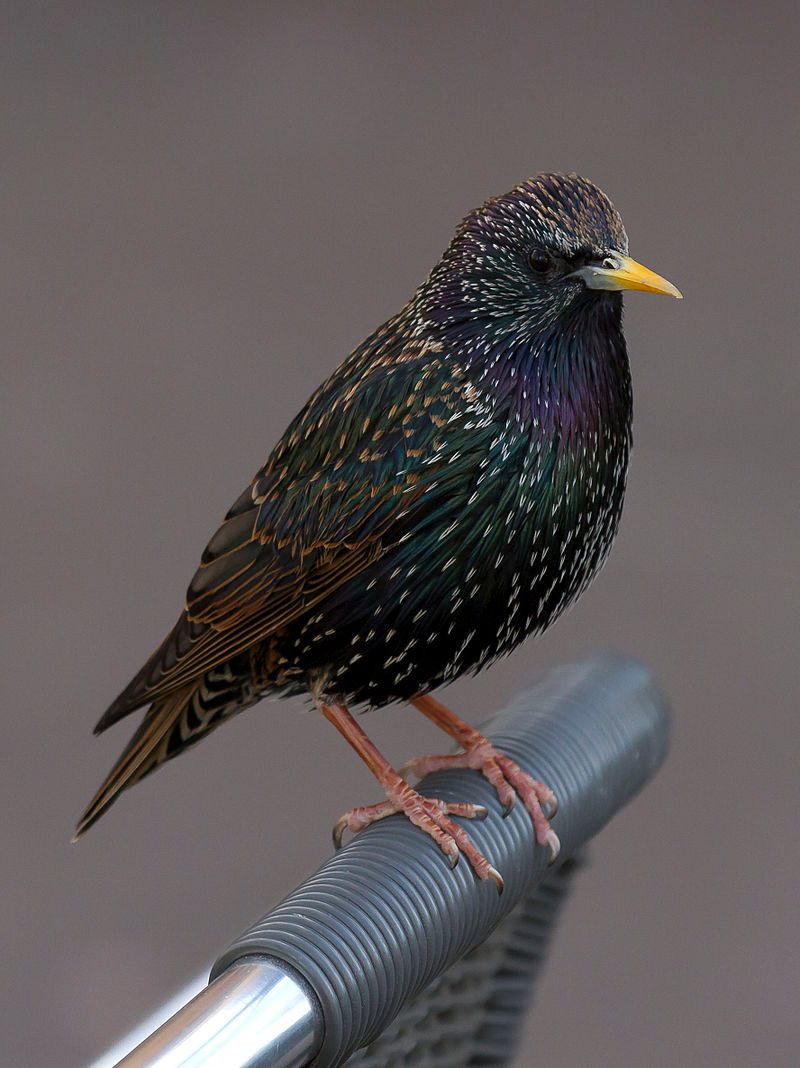
The common starling is a type of bird found in various regions. Depending on the location, it is referred to by different names. It is known as the European starling in North America, while in Great Britain and Ireland, it is simply called the starling.
This bird belongs to the starling family, scientifically known as Sturnidae. The common starling is classified as a passerine bird with its medium-sized build. Passerine birds are characterized by having feet adapted for perching, and they make up the most significant order of birds.
The starling family, to which the common starling belongs, is known for its diverse species worldwide. The common starling is known for its unique features and behaviors. It has a sleek and shiny black plumage with speckled spots, which gives it a distinct appearance.
The bird’s feathers can also appear iridescent in certain lighting conditions, showcasing shades of green and purple. One of the remarkable aspects of the common starling is its ability to mimic sounds and voices.
It has a wide range of vocalizations and can imitate various sounds in its environment, including other bird calls, human speech, and even mechanical noises.
| Kingdom | Animalia |
| Phylum | Chordata |
| Clade | Dinosauria |
| Class | Aves |
| Order | Passeriformes |
| Family | Sturnidae |
| Genus | Sturnus |
| Species | S. vulgaris |
13. Northern Mockingbird
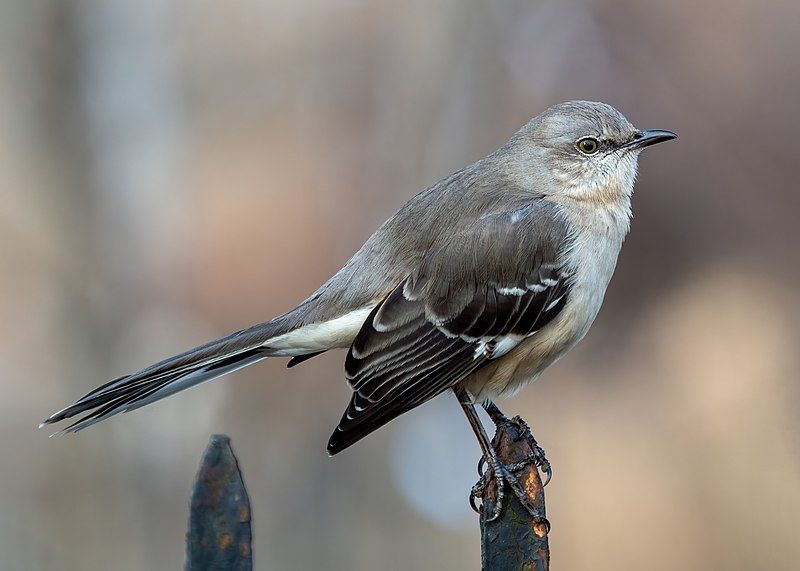
The northern mockingbird is a type of bird that is commonly found in North America. It is known for its ability to mimic the songs of other birds and even sounds from its environment.
This bird is typically seen throughout the year in North America, as it is a permanent resident in the region. However, during extreme weather, such as harsh winters, some northern mockingbirds may decide to migrate south in search of more favorable conditions.
This migration is not shared and only occurs when the weather becomes too challenging for these birds to handle. Despite being primarily found in North America, the northern mockingbird has been occasionally observed in Europe.
However, such sightings are rare, and this species is not considered a regular visitor to the European continent. It is interesting to note the adaptability of the northern mockingbird in terms of its ability to survive in different environments.
While it is mainly found in North America, it can move to more suitable locations during times of adversity. The northern mockingbird’s ability to mimic sounds is a unique characteristic that sets it apart from other bird species.
This skill allows it to imitate the songs of various birds and sounds like car alarms, sirens, or even human speech.
| Kingdom | Animalia |
| Phylum | Chordata |
| Clade | Dinosauria |
| Class | Aves |
| Order | Passeriformes |
| Family | Mimidae |
| Genus | Mimus |
| Species | M. polyglottos |
14. Red-Tailed Hawk
The red-tailed hawk is a type of bird known as a bird of prey. It is found in many different parts of North America. It breeds in a wide range of locations, from the interior of Alaska and northern Canada down to Panama and the West Indies.
This means you can find red-tailed hawks in many places throughout North America. The red-tailed hawk belongs to a group of birds called the genus Buteo. This genus includes many other species of hawks.
However, the red-tailed hawk is one of the most common members of this group, both in North America and worldwide.
This means that you will likely come across a red-tailed hawk more often than other types of hawks within the Buteo genus. The red-tailed hawk is known for its distinctive red tail, which is where it gets its name from.
This feature helps to distinguish it from other types of hawks. However, it is essential to note that not all red-tailed hawks have red tails.
Juvenile red-tailed hawks have brown tails, which only turn red as they mature. Red-tailed hawks are known for their impressive hunting skills.
| Kingdom | Animalia |
| Phylum | Chordata |
| Clade | Dinosauria |
| Class | Aves |
| Order | Accipitriformes |
| Family | Accipitridae |
| Genus | Buteo |
| Species | B. jamaicensis |
15. American Crow
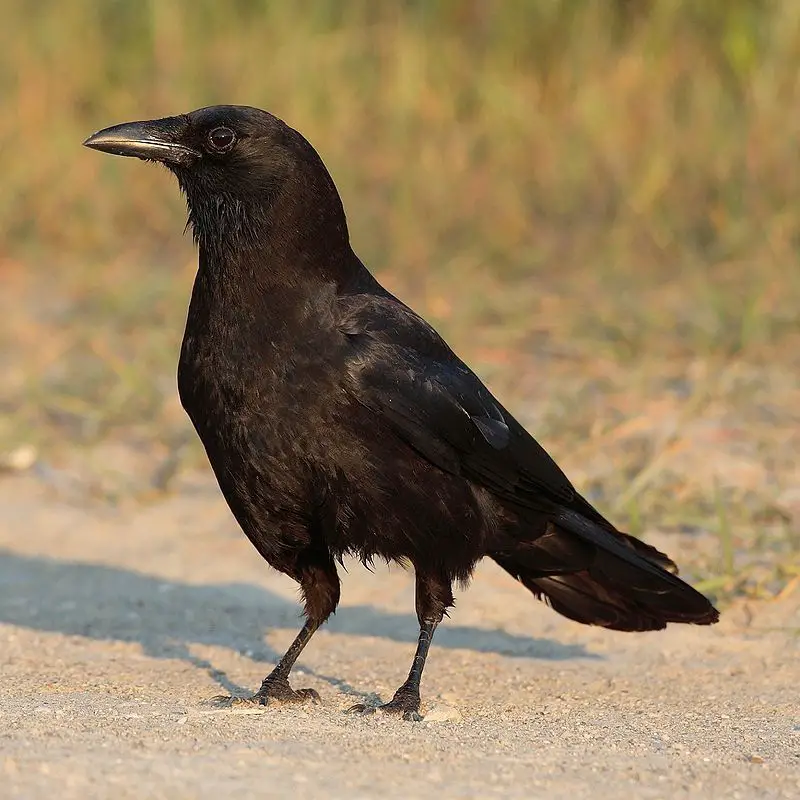
The American crow is a type of bird that belongs to the Corvidae family. This family includes other birds like ravens and jays. The American crow is quite extensive and is known as a passerine bird, meaning it has feet adapted for perching on branches.
You can find American crows in many parts of North America. They are very common birds, so you might have seen them in your neighborhood. They have adapted well to different environments and can be found in urban areas, forests, and open fields.
Interestingly, American crows are similar to two other crows found in different parts of the world. These are the carrion crow and the hooded crow found in Europe and Asia.
Despite being from different continents, these three crows occupy the same ecological niche. An ecological niche refers to the role a species plays in its environment. In this case, the American crow, carrion crow, and hooded crow have similar behaviors and habits.
They are opportunistic feeders, meaning they eat a wide range of things like insects, fruits, small animals, and even garbage. They also play essential roles in controlling populations of certain pests and scavenging.
| Kingdom | Animalia |
| Phylum | Chordata |
| Clade | Dinosauria |
| Class | Aves |
| Order | Passeriformes |
| Family | Corvidae |
| Genus | Corvus |
| Species | C. brachyrhynchos |
16. Northern Flicker
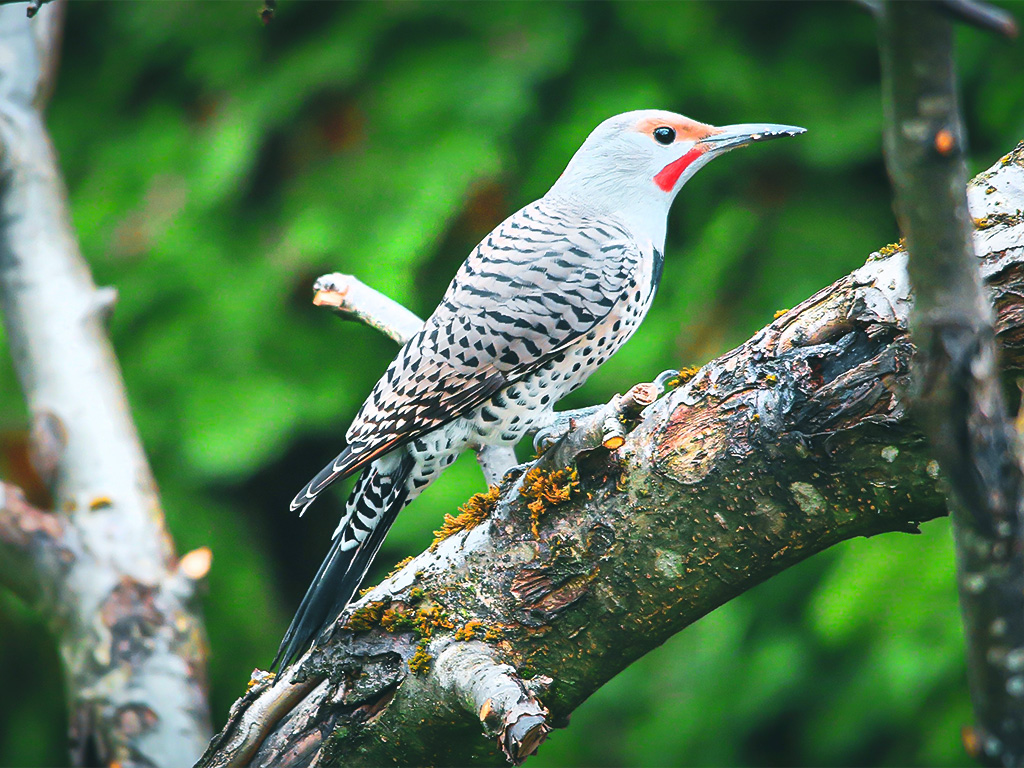
The northern flicker is a bird that belongs to the woodpecker family. It is not a very large bird but also not too small. The northern flicker can be found in many parts of North America.
It is also native to some areas in Central America, such as Cuba and the Cayman Islands. One exciting thing about the northern flicker is that it is one of the few woodpecker species that migrate.
Migration means these birds travel from one place to another during different seasons. They do this to find food and suitable habitats.
The northern flicker migrates to different regions depending on the time of year. During the breeding season, which is usually in the spring or summer, the northern flicker can be found in many parts of North America.
They build their nests in trees and use their strong beaks to create holes in the wood. These holes are called cavities and serve as their homes. Northern flickers are known for their distinctive markings.
They have a brown body with black spots, and their wings have a white patch easily visible when flying. Another unique feature is the red or yellow coloration on the underside of their wings and tail.
| Kingdom | Animalia |
| Phylum | Chordata |
| Clade | Dinosauria |
| Class | Aves |
| Order | Piciformes |
| Family | Picidae |
| Genus | Colaptes |
| Species | C. auratus |
17. Carolina Chickadee
The Carolina chickadee is a type of bird that belongs to the passerine bird family known as Paridae. It is a small bird that is often seen in North America.
The passerine bird family includes other birds like tits, which are known for their small size and agile nature. Carolina chickadees are known for their distinct appearance and behavior. They have a round body shape, short neck, and small beak.
Their feathers are primarily gray on the upperparts and white on the underparts, with black and white markings on their wings and tails.
This coloration helps them blend in with their surroundings and provides camouflage for protection. These birds are often found in deciduous and mixed forests and residential areas with trees and shrubs.
They prefer habitats with a variety of vegetation, including both coniferous and deciduous trees.
They are also known to visit bird feeders in people’s yards, especially during winter, when food is scarce. Carolina chickadees are social birds and are often seen in small flocks.
They communicate with each other through a variety of vocalizations, including their well-known “chick-a-dee-dee-dee” call.
| Kingdom | Animalia |
| Phylum | Chordata |
| Clade | Dinosauria |
| Class | Aves |
| Order | Passeriformes |
| Family | Paridae |
| Genus | Poecile |
| Species | P. carolinensis |
18. White-Breasted Nuthatch
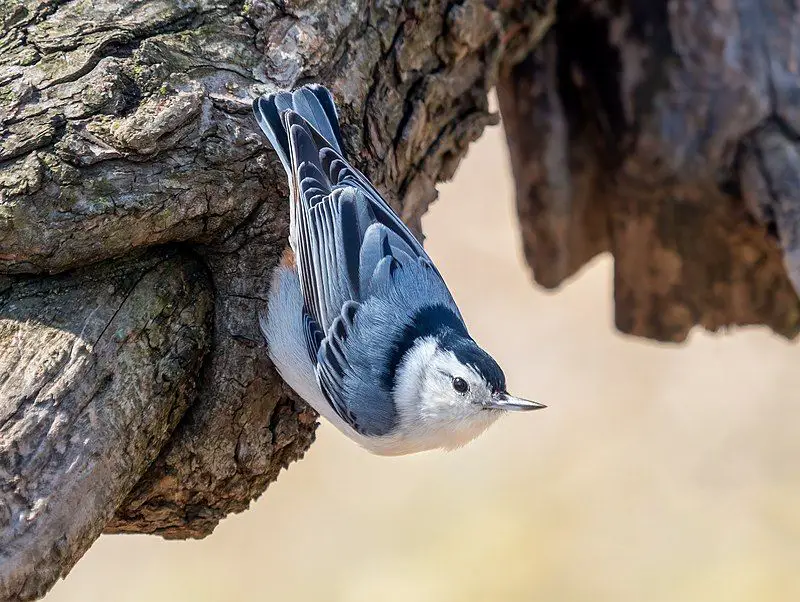
The white-breasted nuthatch is a type of bird that belongs to the nuthatch family called Sittidae.
This family includes various species of nuthatches, but we will focus on the white-breasted nuthatch in this discussion. The white-breasted nuthatch is considered a medium-sized bird, measuring around 15.5 cm in length.
This measurement gives us an idea of its size compared to other birds. While it may not be the most significant bird out there, it is also not the smallest. One exciting feature of the white-breasted nuthatch is its white breast, which gives it its name.
This white coloration on its chest stands out and helps to identify it from other species of nuthatches.
It is worth noting that not all nuthatches have this specific feature, making it unique to the white-breasted nuthatch. As a nuthatch family member, the white-breasted nuthatch shares specific characteristics with other nuthatch species.
For example, nuthatches are known for their ability to climb up and down trees headfirst. This behavior is quite fascinating to observe, as most birds can only move in an upward direction.
| Kingdom | Animalia |
| Phylum | Chordata |
| Clade | Dinosauria |
| Class | Aves |
| Order | Passeriformes |
| Family | Sittidae |
| Genus | Sitta |
| Species | S. carolinensis |
19. White-Throated Sparrow
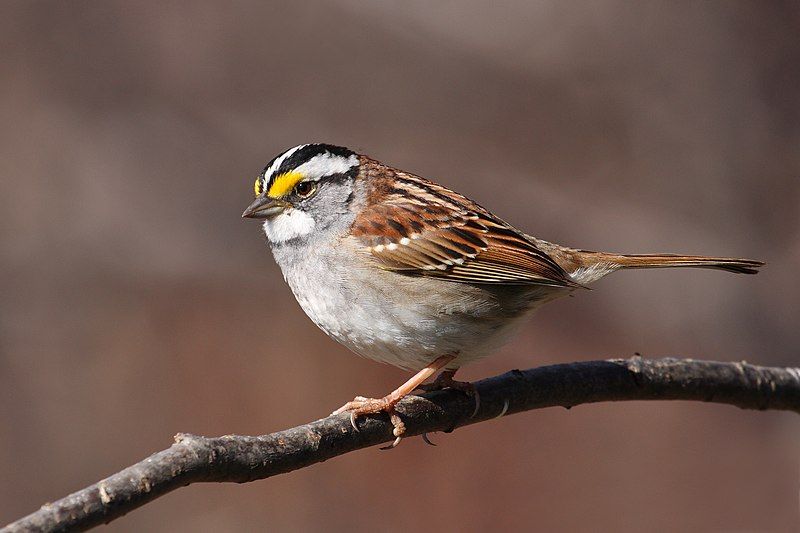
The white-throated sparrow is a type of bird that belongs to the passerine family called Passerellidae. This family of birds is commonly known as New World sparrows. Passerines are a diverse group of birds that make up more than half of all bird species.
They are known for their unique ability to perch and grip onto branches with their feet. The white-throated sparrow is easily distinguished by the white patch on its throat. This feature gives the bird its name.
These sparrows are native to North America and can be found throughout the continent, from Canada to Mexico. They are migratory birds, meaning they travel long distances during certain times of the year.
During the breeding season, white-throated sparrows are known for their distinct song, which can be described as a whistling “Oh sweet Canada, Canada, Canada.” This song helps them attract mates and establish their territory.
White-throated sparrows are relatively small birds, measuring about 6 to 7 inches long. They have a plump body with a rounded head and a short tail. Their plumage consists of a combination of gray, brown, and black feathers.
| Kingdom | Animalia |
| Phylum | Chordata |
| Clade | Dinosauria |
| Class | Aves |
| Order | Passeriformes |
| Family | Passerellidae |
| Genus | Zonotrichia |
| Species | Z. albicollis |
20. Carolina Wren
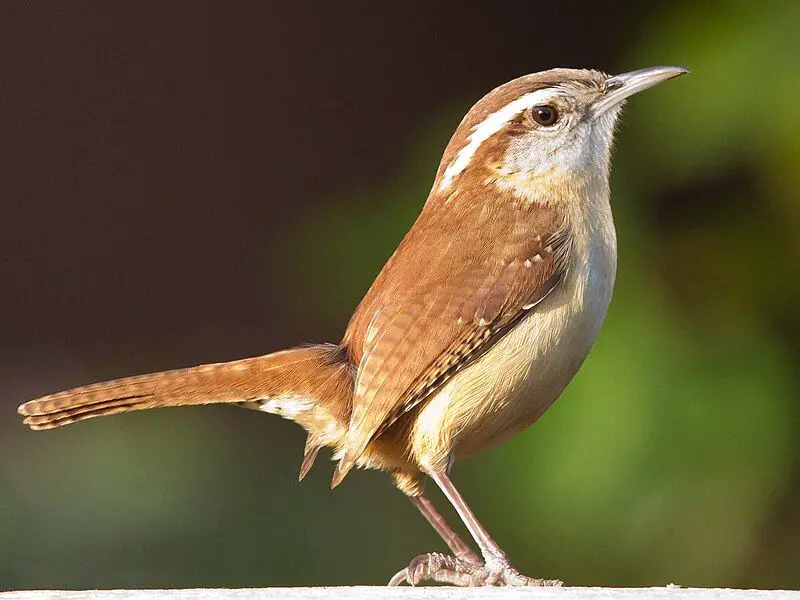
The Carolina wren is a type of wren bird found in several regions. It is considered a common species, frequently seen in these areas. The bird is mainly found in the eastern half of the United States of America.
This includes states like North Carolina, South Carolina, and Virginia. However, it can also be spotted in other states within this region. Apart from the United States, the Carolina wren is also seen in certain parts of Canada.
Specifically, it can be found in the extreme south of Ontario. This means it is only present in the southernmost part of the province.
This is interesting because the bird’s range extends beyond the borders of the United States. Additionally, the Carolina wren can be observed in the extreme northeast of Mexico.
This means it is found in the northeastern part of the country, close to the border it shares with the United States.
This further highlights the bird’s ability to inhabit different regions within North America. The Carolina wren is a resident bird in the eastern half of the United States, the extreme south of Ontario, Canada, and the extreme northeast of Mexico.
It is a common species, often seen in these areas. Its range includes several states.
| Kingdom | Animalia |
| Phylum | Chordata |
| Clade | Dinosauria |
| Class | Aves |
| Order | Passeriformes |
| Family | Troglodytidae |
| Genus | Thryothorus |
| Species | T. ludovicianus |
21. Red-Winged Blackbird
The red-winged blackbird is a type of bird that belongs to the passerine family called Icteridae.
It is commonly found in various parts of North America and a significant portion of Central America. Passerines are a diverse group of birds known for their musical and complex songs.
They have specialized vocal organs that produce a wide range of sounds. The red-winged blackbird is easily recognizable due to its distinct appearance.
The male red-winged blackbird has glossy black plumage and bright red patches on its wings, which give it its name.
On the other hand, the female red-winged blackbird has a more subdued appearance with brown feathers and streaks. These birds have a unique habitat preference, as they are commonly found in wetlands, marshes, and areas with tall grasses.
They are skilled at perching on tall plants and reeds, where they can easily spot their prey and potential predators. Red-winged blackbirds primarily feed on insects, seeds, and grains. They use their sharp beaks to catch insects on the fly and extract seeds from plants.
During the breeding season, they may consume small vertebrates such as frogs and tadpoles.
| Kingdom | Animalia |
| Phylum | Chordata |
| Clade | Dinosauria |
| Class | Aves |
| Order | Passeriformes |
| Family | Icteridae |
| Genus | Agelaius |
| Species | A. phoeniceus |
22. Canada Goose
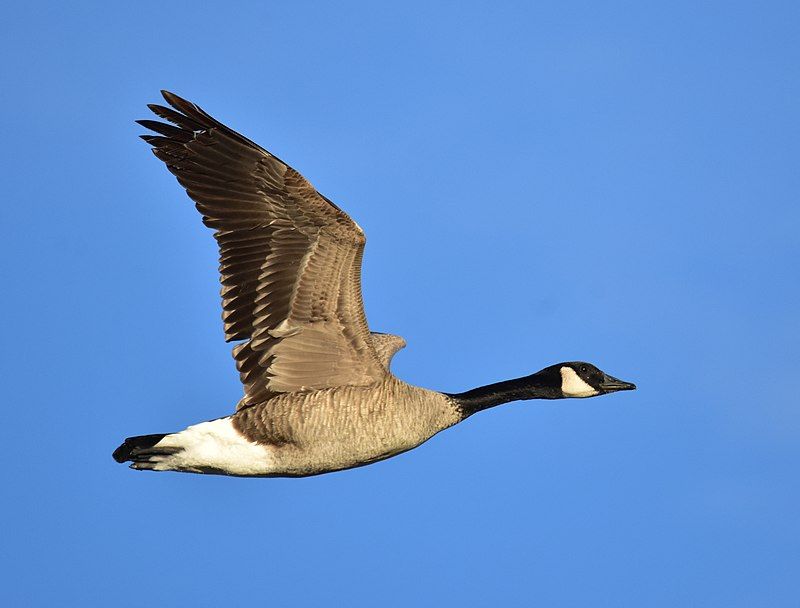
The Canada goose is a type of wild goose that can also be called the Canadian goose. It is pretty large and has distinct physical features. One of its notable characteristics is a black head and neck.
Additionally, it has white cheeks and a white area under its chin. The body of the Canada goose is typically brown. This goose species is originally from the arctic and temperate regions of North America. It is well-adapted to these colder climates.
However, during migration, the Canada goose has been known to travel across the Atlantic and can occasionally be found in northern Europe. The Canada goose is a fascinating bird that has captured the attention of many due to its unique appearance.
Its black head and neck contrast sharply against its white cheeks and chin.
This distinctive coloration helps to identify the Canada goose from other species easily. Native to North America’s arctic and temperate regions, the Canada goose has evolved to survive in harsh environments.
Its adaptations to cold climates include a sturdy build and insulating feathers.
These features enable the goose to endure freezing temperatures and harsh weather conditions. Although primarily found in North America, the Canada goose displays an exciting behavior during migration.
| Kingdom | Animalia |
| Phylum | Chordata |
| Clade | Dinosauria |
| Class | Aves |
| Order | Anseriformes |
| Family | Anatidae |
| Genus | Branta |
| Species | B. canadensis |
23. Turkey Vulture
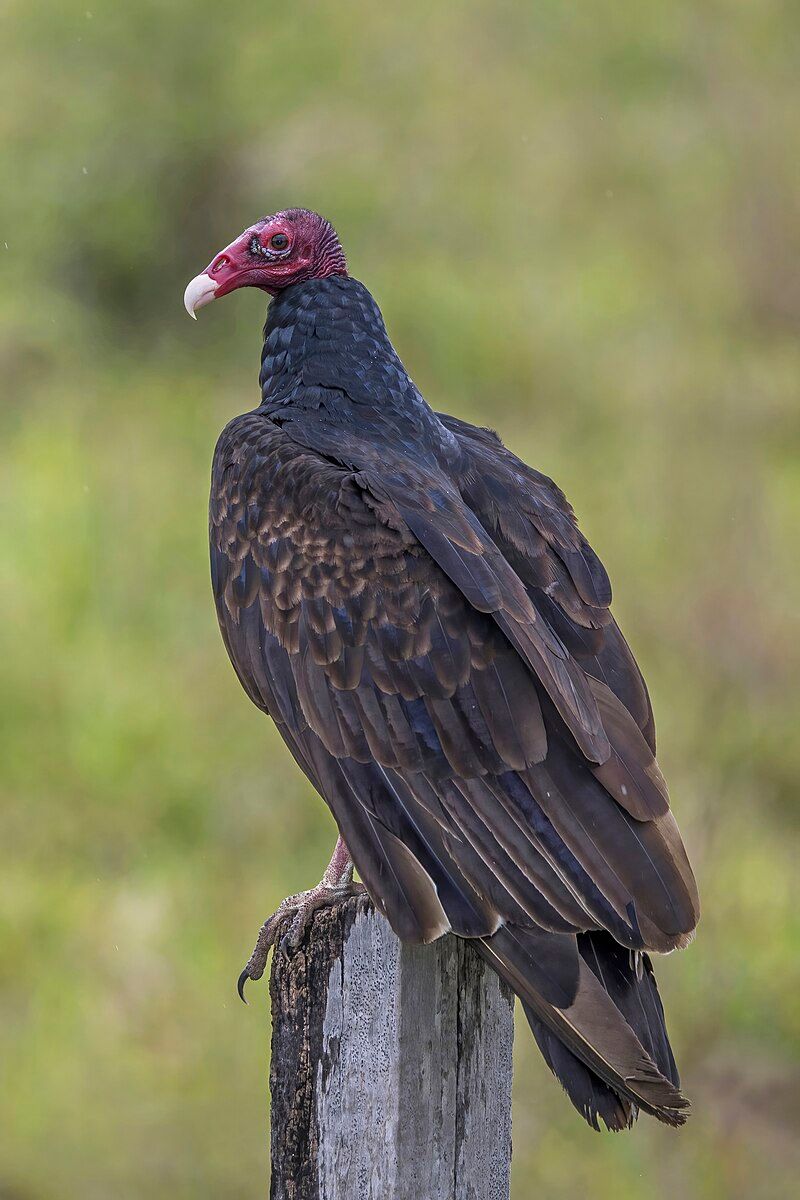
The turkey vulture is a type of vulture found in many different parts of the Americas. It is the most widespread of all the New World vultures. There are three species of vultures in a group called the genus Cathartes.
The turkey vulture is one of these species. It belongs to the family Cathartidae, a bird group that includes vultures. The turkey vulture can be found in a vast range of locations.
It can be seen from southern Canada down to the very tip of South America. This means it can be found in many different countries and environments throughout the Americas. This bird has an extensive range because it is well adapted to various habitats.
It can thrive in a wide range of conditions and climates. The turkey vulture is known for its characteristic appearance. It has a bald head, which is red. Its body is primarily black or dark brown, with long wings and a long tail.
This vulture is a scavenger, meaning it feeds on dead animals. It has a highly developed sense of smell, which allows it to locate carrion from high.
| Kingdom | Animalia |
| Phylum | Chordata |
| Clade | Dinosauria |
| Class | Aves |
| Order | Accipitriformes |
| Family | Cathartidae |
| Genus | Cathartes |
| Species | C. aura |
24. Great Blue Heron
The great blue heron is a bird that belongs to the heron family called Ardeidae. It is a big bird that is often seen wading in water. You can find it near the shores of open water and in wetlands in many parts of North and Central America.
It is also found in far northwestern South America, the Caribbean, and even the Galápagos Islands. These herons are known for their tall and slender bodies, long legs and a long neck.
They have a distinctive blue-gray coloration on their feathers, which gives them their name.
They also have a large, dagger-like beak to catch their prey. You can often spot great blue herons standing still in shallow water, patiently waiting for fish or other small animals to come by.
They are excellent hunters and have sharp eyesight, which helps them spot their prey from a distance.
Once they see a potential meal, they use their long necks to strike quickly and snatch it up with their beaks. While they primarily feed on fish, these herons are also known to eat amphibians, reptiles, and even small mammals.
Their diet depends on what is available in their habitat. They are adaptable.
| Kingdom | Animalia |
| Phylum | Chordata |
| Clade | Dinosauria |
| Class | Aves |
| Order | Pelecaniformes |
| Family | Ardeidae |
| Genus | Ardea |
| Species | A. herodias |
25. House Sparrow
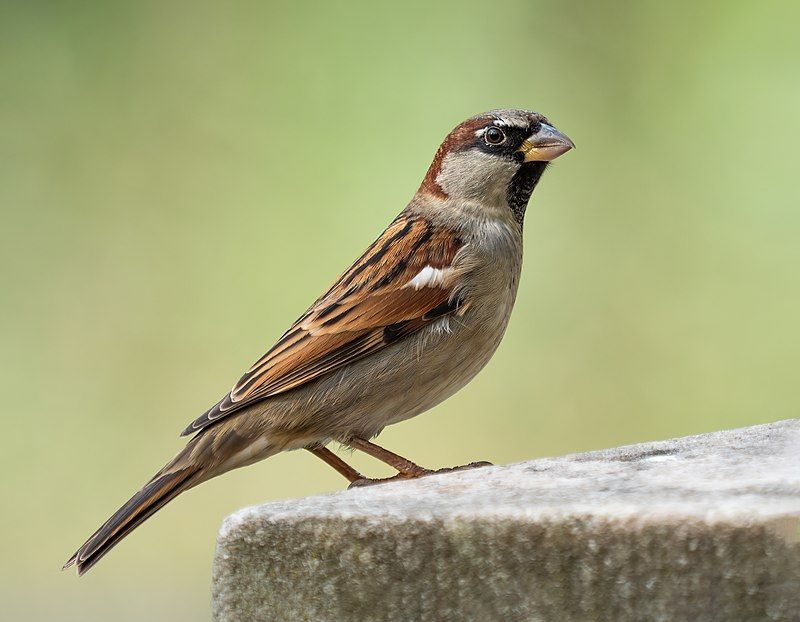
The house sparrow is a type of bird that belongs to the sparrow family called Passeridae. These birds can be found in many different parts of the world. They are pretty small, typically measuring about 16 cm in length.
In terms of weight, they usually range between 24 to 39.5 grams. Regarding their appearance, female and young house sparrows are generally colored in pale shades of brown and grey.
This coloration helps them blend in with their surroundings and provides them with some camouflage. On the other hand, male house sparrows have more vibrant colors.
They display black, white, and brown markings, making them easily distinguishable from the females and young birds. The contrasting colors of the male house sparrows serve various purposes. Firstly, these colors help attract mates during the breeding season.
The brighter markings act as a visual signal to the females, indicating that the male is healthy and capable of providing for offspring.
These markings also play a role in defending territory and establishing dominance among other male sparrows. The house sparrow’s coloration is not only limited to their feathers. They also have distinct beak colors that differ between males and females.
| Kingdom | Animalia |
| Phylum | Chordata |
| Clade | Dinosauria |
| Class | Aves |
| Order | Passeriformes |
| Family | Passeridae |
| Genus | Passer |
| Species | P. domesticus |
26. Red-Shouldered Hawk
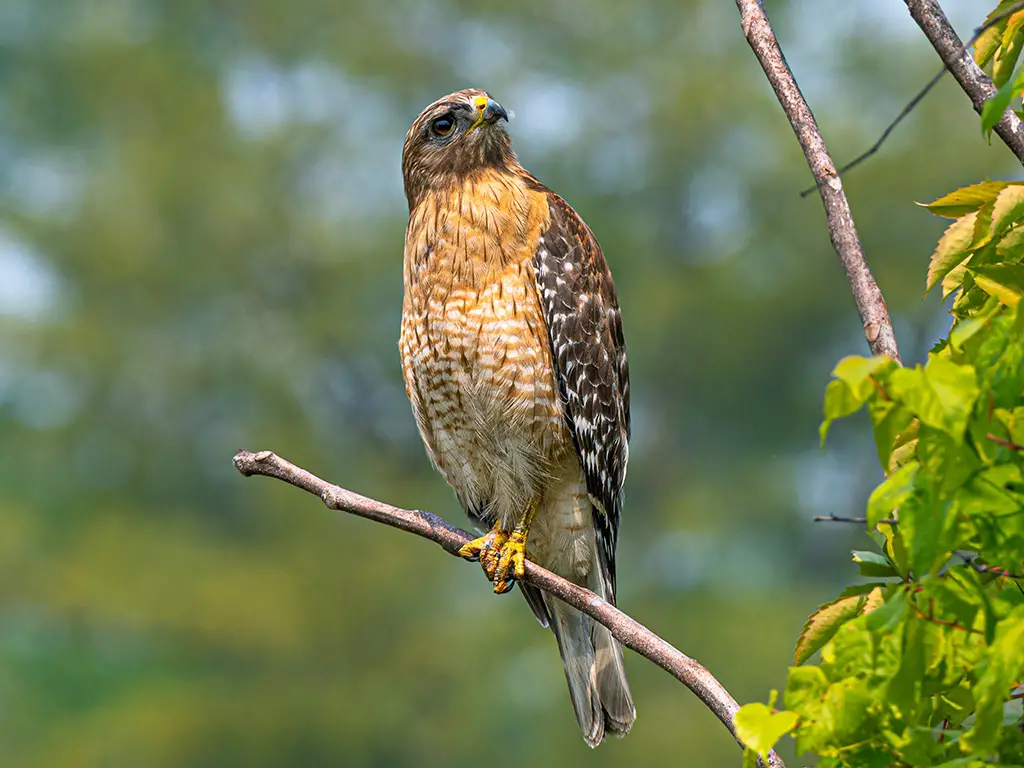
The red-shouldered hawk is a type of bird known as a medium-sized buteo. It can be found in various parts of North America, specifically in the eastern region, along the California coast, and in northern to northeastern-central Mexico.
This bird species is not migratory, as it is a permanent resident in most of its range. It chooses to stay in these areas year-round. However, there are some red-shouldered hawks in the northern parts of its range that do migrate.
They typically travel to central Mexico during their migration. The red-shouldered hawk is often seen in forests and woodlands, where it builds its nests and hunts for food. It prefers these habitats due to the availability of prey and suitable nesting sites.
These hawks have adapted to these environments and have become well-suited to their surroundings. As a medium-sized buteo, the red-shouldered hawk has specific characteristics that distinguish it from other birds.
Its size is not too large nor too small, making it a medium-sized bird. This allows it to have a good balance between agility and strength, aiding its hunting and survival. One notable feature of the red-shouldered hawk is its red.
| Kingdom | Animalia |
| Phylum | Chordata |
| Clade | Dinosauria |
| Class | Aves |
| Order | Accipitriformes |
| Family | Accipitridae |
| Genus | Buteo |
| Species | B. lineatus |
27. Mallard
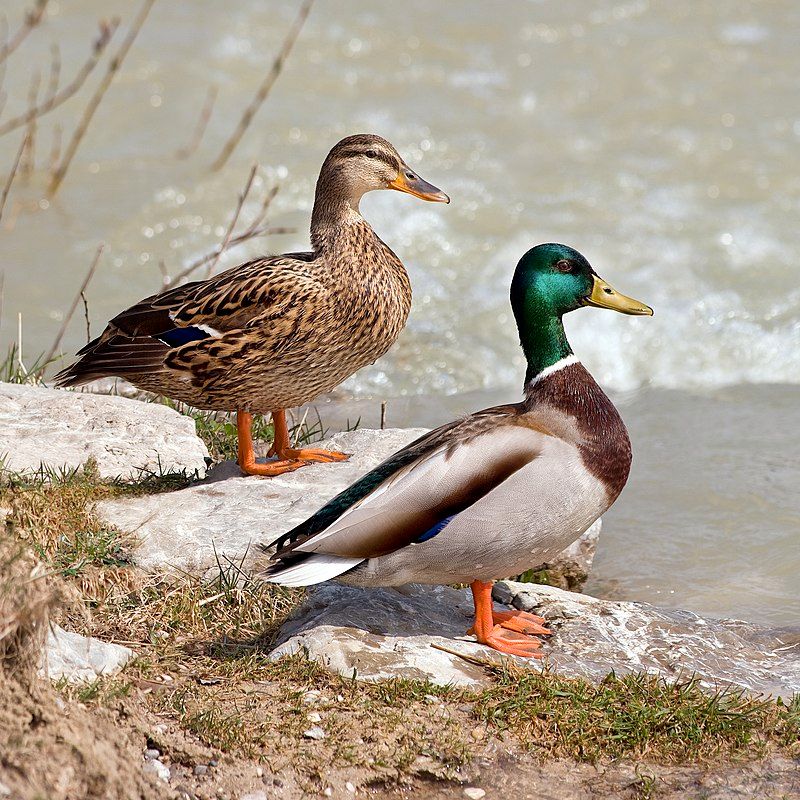
The mallard, also known as the wild duck, is a dabbling duck. It can be found breeding in various world regions, including the temperate and subtropical Americas, Eurasia, and North Africa.
This duck species has been introduced to several countries outside its native range. For example, mallards have been brought to New Zealand, Australia, Peru, Brazil, Uruguay, Argentina, Chile, Colombia, the Falkland Islands, and South Africa.
The mallard’s ability to adapt to different environments has allowed it to thrive in these introduced regions. It is a versatile bird that can adapt to various habitats, such as wetlands, ponds, lakes, and even urban areas. In its native range, the mallard is a migratory bird.
However, in some introduced areas, it has become resident, meaning it stays in one place throughout the year rather than undertaking long-distance migrations.
The mallard is known for its vibrant plumage, with males having a distinctive green head, yellow bill, and brownish body. Conversely, females have a mottled brown appearance, which helps them camouflage with their surroundings. As dabbling ducks, mallards feed.
| Kingdom | Animalia |
| Phylum | Chordata |
| Clade | Dinosauria |
| Class | Aves |
| Order | Anseriformes |
| Family | Anatidae |
| Genus | Anas |
| Species | A. platyrhynchos |
28. Ruby-Throated Hummingbird
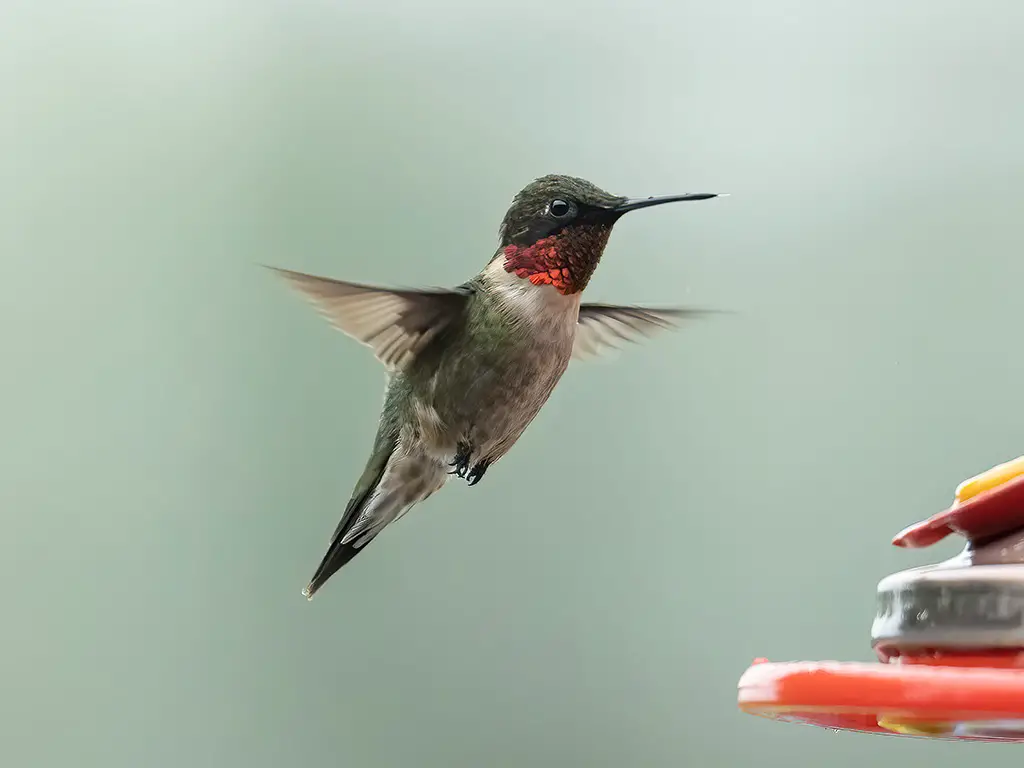
The ruby-throated hummingbird is a type of hummingbird that has a bright red throat. This species is known for its unique migration pattern. These hummingbirds can be found in Central America, Mexico, and Florida during the winter months.
They choose these warmer regions because they provide a more suitable climate for survival. However, the ruby-throated hummingbird embarks on an incredible journey when the summer season arrives.
They migrate to Canada and other parts of Eastern North America to breed.
This long-distance migration allows them to take advantage of the abundant resources available in these areas during the summer months. The reason behind this seasonal migration is quite fascinating.
In Central America, Mexico, and Florida, the ruby-throated hummingbirds find a variety of nectar-producing flowers that provide them with a sufficient food source.
These flowers bloom during the winter, ensuring the hummingbirds have enough energy to survive. But as the seasons shift and the temperatures rise, the flowers in these regions begin to wither away.
This scarcity of food prompts the hummingbirds to undertake their impressive journey northward. They instinctively know that Canada and Eastern North America offer abundant nectar-producing flowers during the summer, which is ideal for them.
| Kingdom | Animalia |
| Phylum | Chordata |
| Clade | Strisores |
| Class | Aves |
| Order | Apodiformes |
| Family | Trochilidae |
| Genus | Archilochus |
| Species | A. colubris |
29. Pine Warbler
The pine warbler is a type of bird. It belongs to the New World warbler family. This family includes various species of small songbirds. The pine warbler is one of them.
It is known for its beautiful songs and melodies. Being a small bird, the pine warbler is not very large. It has a slender body can measure around 5 to 6 inches in length.
Its small size allows it to move swiftly through the trees and vegetation. The pine warbler is primarily found in North America. It is commonly seen in the eastern parts of the United States and Canada, particularly in areas with pine forests.
These birds prefer to inhabit the coniferous forests, where they can find suitable nesting places and sources of food. As their name suggests, pine warblers have a particular affinity for pine trees. They are well adapted to living in these environments.
The birds have developed specific characteristics that help them thrive in pine forests.
For example, their coloration allows them to blend in with the pine needles and branches, providing camouflage and protection from predators. One of the distinctive features of the pine warbler is its yellow plumage.
The males have a brighter yellow coloration, while the females are slightly.
| Kingdom | Animalia |
| Phylum | Chordata |
| Clade | Dinosauria |
| Class | Aves |
| Order | Passeriformes |
| Family | Parulidae |
| Genus | Setophaga |
| Species | S. pinus |
30. Pileated Woodpecker
The pileated woodpecker is a type of bird that is primarily black and is found in North America. It is a relatively large bird compared to other woodpeckers. The pileated woodpecker mostly eats insects, which makes it an insectivore.
It usually lives in deciduous forests located in eastern North America. In addition to the east part of North America, the pileated woodpecker can also be found in the Great Lakes region. This means it can be seen in Michigan, Minnesota, and the surrounding states.
The bird is also found in the boreal forests of Canada. These forests are characterized by primarily coniferous trees and are located in northern Canada. Furthermore, the pileated woodpecker can be spotted in certain areas along the Pacific Coast.
This means it can be found in states like Oregon and Washington. It is interesting that the bird’s habitat spans different regions, showing its adaptability to various environments.
Overall, the pileated woodpecker is a fascinating bird native to North America. Its black feathers and relatively large size make it easy to identify. It prefers to live in deciduous forests.
| Kingdom | Animalia |
| Phylum | Chordata |
| Clade | Dinosauria |
| Class | Aves |
| Order | Piciformes |
| Family | Picidae |
| Genus | Dryocopus |
| Species | D. pileatus |
31. Brown-Headed Cowbird
The brown-headed cowbird is a bird species found in temperate and subtropical regions of North America. It is known for its behavior as a brood parasite, meaning it lays its eggs in the nests of other bird species.
This behavior is obligatory for the brown-headed cowbird, which means it relies on other birds to raise its young. The brown-headed cowbird is a small bird with a brown head and dark body.
It is commonly found in the southern parts of its range throughout the year, where it remains a permanent resident.
However, the birds from the northern regions migrate to the southern United States and Mexico during the winter season.
The migration of the northern brown-headed cowbirds occurs because the colder conditions in their northern habitats make it challenging to find sufficient food during the winter months.
Traveling to the southern regions, where the climate is milder and food resources are more abundant, increases their chances of survival. The migration typically takes place in a southward direction, starting around the onset of winter.
These birds undertake a long journey, often flying miles to reach their wintering grounds. They remain in these warmer regions until spring, around March or April, after winter.
| Kingdom | Animalia |
| Phylum | Chordata |
| Clade | Dinosauria |
| Class | Aves |
| Order | Passeriformes |
| Family | Icteridae |
| Genus | Molothrus |
| Species | M. ater |
32. Eastern Towhee
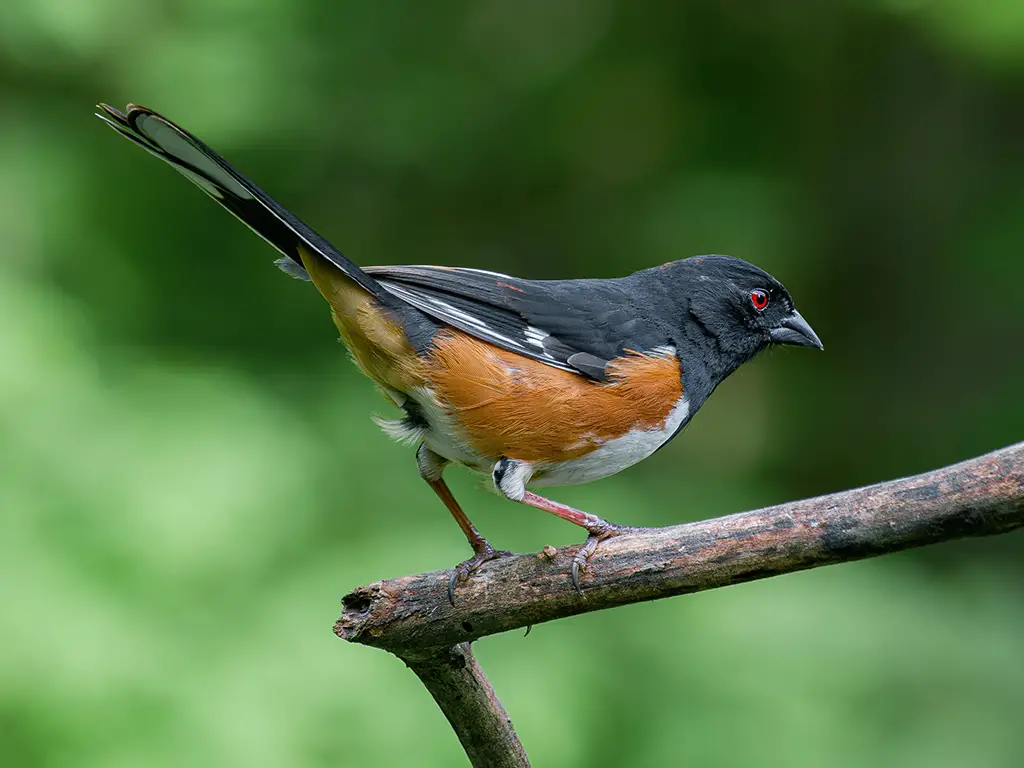
The eastern towhee is a type of sparrow found in the New World. It is a relatively large sparrow compared to other species. However, there has been some disagreement among scientists about the classification of towhees in recent years.
In the past, the eastern towhee and the spotted towhee were thought to be the same species called the rufous-sided towhee. The debate about the taxonomy of towhees has caused confusion and uncertainty among experts.
They have been trying to determine the exact relationship between the eastern towhee and the spotted towhee.
This has led to discussions and research better to understand the differences and similarities between these two birds. Despite the taxonomic debate, it is agreed that the eastern towhee has a specific breeding habitat in brushy areas across eastern North America.
This means they prefer to build their nests and raise their young in areas filled with dense vegetation and shrubs. The brushy areas provide the eastern towhees with the necessary cover and protection for their breeding activities.
These habitats are abundant in eastern North America, making it an ideal place for the east towhee to thrive and reproduce by studying the breeding habitats of the eastern towhee.
| Kingdom | Animalia |
| Phylum | Chordata |
| Clade | Dinosauria |
| Class | Aves |
| Order | Passeriformes |
| Family | Passerellidae |
| Genus | Pipilo |
| Species | P. erythrophthalmus |
33. Brown Creeper
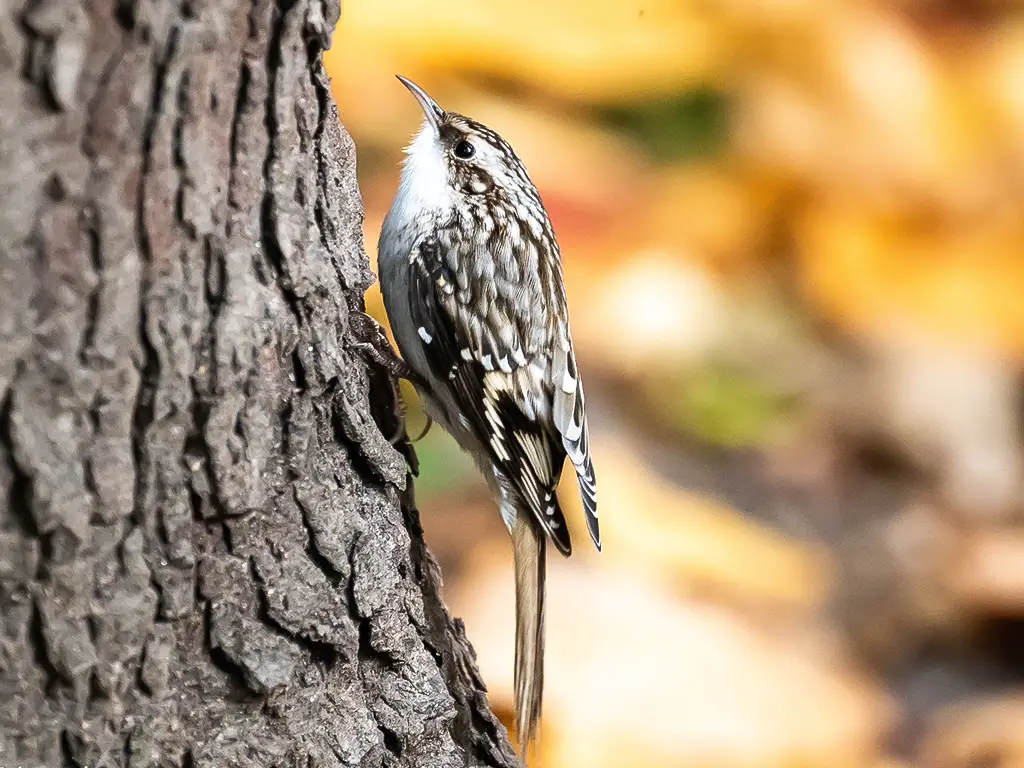
The brown creeper is a small bird called the American treecreeper. It belongs to the treecreeper family called Certhiidae.
This bird is found only in North America, making it the only member of its family in this region. The brown creeper is known for its unique behavior of climbing up tree trunks. It has a curved bill that helps it search for insects and spiders residing in the bark of trees.
The bird uses its stiff tail feathers as a support while spiraling up the trees in a spiral pattern. The brown creeper has a distinct appearance. It has brown feathers that blend well with the bark of trees, providing camouflage and making it difficult to spot.
The bird has a white underbelly with streaks of brown, which helps it blend in with the tree trunks. This small songbird measures about 12-14 centimeters in length and weighs around 9-14 grams. It has a wingspan of approximately 18-20 centimeters.
The brown creeper’s body is slender, allowing it to maneuver easily among trees. These birds are primarily found in mature forests with a dense canopy. They prefer habitats with a mix of deciduous and coniferous.
| Kingdom | Animalia |
| Phylum | Chordata |
| Clade | Dinosauria |
| Class | Aves |
| Order | Passeriformes |
| Family | Certhiidae |
| Genus | Certhia |
| Species | C. americana |
34. Cooper’s Hawk
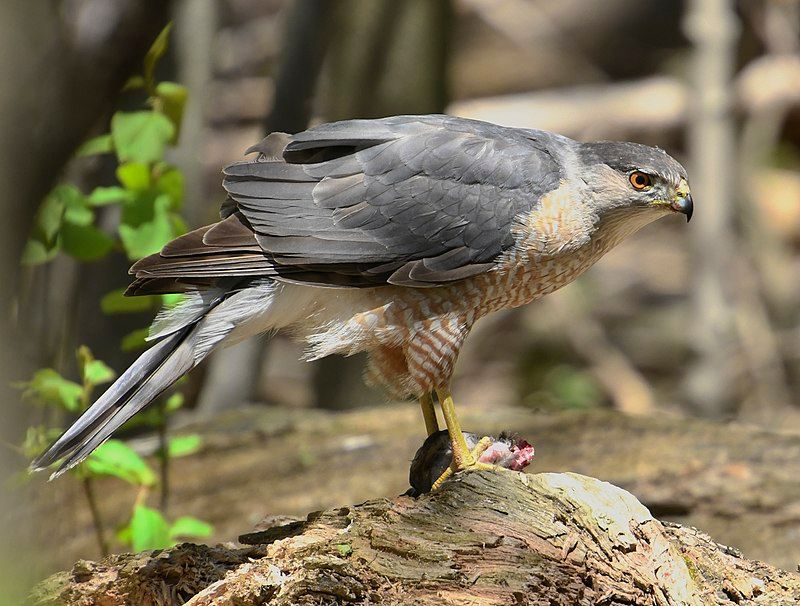
The Cooper’s hawk is a type of hawk found in North America. It is considered to be a medium-sized bird.
This species is native to the continent and commonly found in various regions ranging from southern Canada to Mexico. One attractive characteristic of the Cooper’s hawk is its size.
It falls into the category of medium-sized hawks, which means it is neither too big nor too small. This size allows the hawk to adapt and survive in different habitats across North America. The distribution of the Cooper’s hawk is quite extensive.
It can be found in North America, including southern Canada, the United States, and Mexico.
This wide range of habitats gives the hawk ample opportunities to thrive and establish its presence in various ecosystems. Despite its widespread distribution, the Cooper’s hawk is not evenly distributed throughout its range.
It tends to be more common in certain areas and less abundant in others. This variation in population density might be influenced by factors such as the availability of prey, nesting sites, and overall habitat suitability. The Cooper’s hawk is known for its hunting skills.
It primarily feeds on small to medium-sized birds, which it catches by surprise with speed and agility. This hawk is well-adapted.
| Kingdom | Animalia |
| Phylum | Chordata |
| Clade | Dinosauria |
| Class | Aves |
| Order | Accipitriformes |
| Family | Accipitridae |
| Genus | Accipiter |
| Species | A. cooperii |
35. Common Grackle
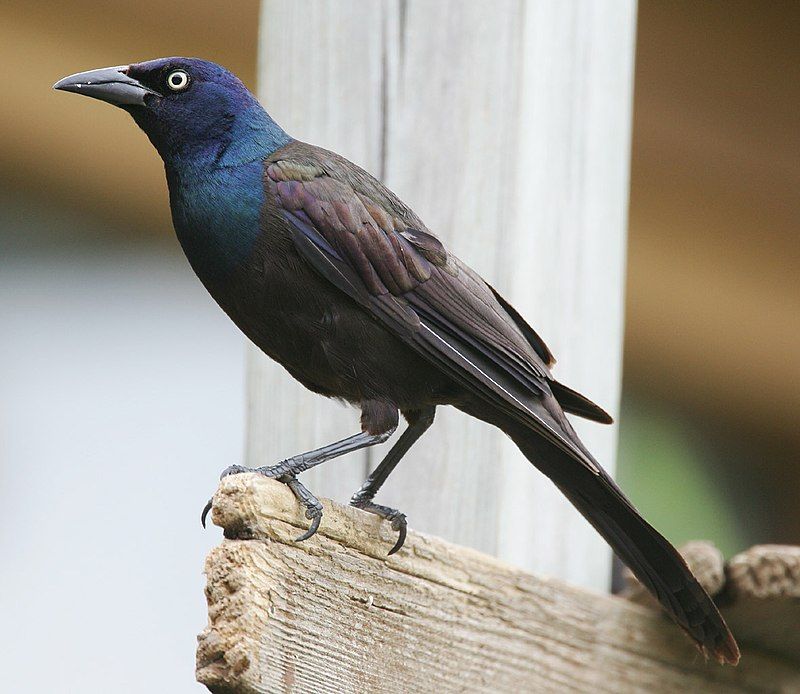
The common grackle is a bird found in many parts of North America. It was first identified and described by a scientist named Carl Linnaeus in 1758. This bird belongs to a family of birds known as icterids.
One exciting thing about the common grackle is its three different subspecies. This means there are slight variations in appearance among the various groups of these birds. When an adult common grackle is fully grown, it has certain distinct features.
For example, it has a long bill that is dark in color. The bird uses this bill to catch and eat its food. The common grackle also has pale yellow eyes, which add to its unique appearance. Another noticeable characteristic of the adult common grackle is its long tail.
This tail is an essential part of the bird’s body, as it helps with balance and maneuverability during flight. It is worth noting that the common grackle is a reasonably large bird compared to some other species.
Its size contributes to its visibility and makes it easier to spot in its natural habitat. The common grackle is an exciting bird species with distinct physical traits. It’s large numbers across the North.
| Kingdom | Animalia |
| Phylum | Chordata |
| Clade | Dinosauria |
| Class | Aves |
| Order | Passeriformes |
| Family | Icteridae |
| Genus | Quiscalus |
| Species | Q. quiscula |
36. Indigo Bunting
The indigo bunting is a bird that belongs to the cardinal family. It is known for its small size and diet, mainly of seeds. This bird is migratory, meaning it travels from one place to another depending on the season.
It can be found in southern Canada up to northern Florida during the breeding season. However, during the winter, it moves to southern Florida and even as far as northern South America. Interestingly, the indigo bunting has a unique way of migrating.
It prefers to travel at night, using the stars as a guide. This ability to use celestial cues demonstrates the bird’s remarkable sense of direction.
It can accurately find its way to its desired destination by relying on the stars. Migrating at night provides certain advantages for the indigo bunting. Firstly, the cooler temperatures at night make it more comfortable for the bird to travel long distances.
Additionally, flying during the night reduces the risk of predation, as many predators are less active during those hours.
This allows the indigo bunting to avoid potential dangers and increases its chances of survival during its journey. The indigo bunting’s reliance on the stars also showcases its ability to perceive and interpret celestial patterns.
| Kingdom | Animalia |
| Phylum | Chordata |
| Clade | Dinosauria |
| Class | Aves |
| Order | Passeriformes |
| Family | Cardinalidae |
| Genus | Passerina |
| Species | P. cyanea |
37. Yellow-Rumped Warbler
The yellow-rumped warbler is a type of bird that is found in North America. It is pretty standard and can be seen everywhere across the continent. This bird species is known for its distinct yellow feathers on its rump or lower back.
This is where it gets its name from. These yellow feathers make it easy to identify the yellow-rumped warbler in the wild. The yellow-rumped warbler is a small bird, measuring around 5 to 6 inches in length. It has a slim body with a pointed beak and long wings.
Its wingspan can reach 9 to 10 inches, allowing it to fly swiftly and gracefully. One interesting fact about this bird is that it is known for its ability to migrate long distances. Yellow-rumped warblers can be found in North America during the breeding season.
However, they migrate south to warmer regions, such as Mexico and Central America, when winter arrives. This bird species can be found in a variety of habitats. It is often seen in forests, woodlands, and even urban areas.
It has adapted well to different environments and can thrive in deciduous and coniferous forests. The yellow-rumped warbler has a diverse.
| Kingdom | Animalia |
| Phylum | Chordata |
| Clade | Dinosauria |
| Class | Aves |
| Order | Passeriformes |
| Family | Parulidae |
| Genus | Setophaga |
| Species | S. coronata |
38. Eastern Phoebe
The eastern phoebe is a small bird that belongs to the passerine family. This family includes birds with feet specially adapted for perching, singing, and eating seeds or insects.
The eastern phoebe is one of these birds. The scientific name of the east phoebe is Sayornis. This name is derived from the specific part of Charles Lucien Bonaparte’s name for Say’s phoebe, another closely related bird species.
Charles Lucien Bonaparte, a French ornithologist, discovered and named several bird species. The specific name for Say’s phoebe, Muscicapa saya, was taken by Bonaparte and combined with the Ancient Greek word “ornis,” which means “bird.”
This combination resulted in the genus name Sayornis for the eastern phoebe. The genus name is essential in scientific classification because it helps scientists categorize and identify different species.
Using a standardized naming system, scientists can communicate more effectively about specific birds and their characteristics. In this case, the genus name Sayornis indicates that the eastern phoebe is closely related to Say’s phoebe.
It helps scientists understand the evolutionary relationships between these two species.
| Kingdom | Animalia |
| Phylum | Chordata |
| Clade | Dinosauria |
| Class | Aves |
| Order | Passeriformes |
| Family | Tyrannidae |
| Genus | Sayornis |
| Species | S. phoebe |
39. Yellow-Bellied Sapsucker

The yellow-bellied sapsucker is a bird that belongs to the woodpecker family. It is not too big or too small, but rather a medium-sized bird. This bird can be found in two specific regions: Canada and the northeastern part of the United States.
The yellow-bellied sapsucker is known for its distinct appearance. It has a yellow belly, where it gets its name. This bright yellow color stands out against the bird’s black and white feathers. This woodpecker has a unique behavior when it comes to feeding.
It mainly relies on tree sap as its primary food source. It drills tiny holes in tree trunks using its strong beak and long tongue to extract the sap. This behavior of drilling holes is why it is called a sapsucker.
Apart from sap, this bird also feeds on insects, fruits, and berries. It has a diverse diet, including insects like ants, beetles, and caterpillars. Additionally, it enjoys consuming fruits and berries when they are available.
Breeding is an essential aspect of the yellow-bellied sapsucker’s life cycle. It chooses to breed in two specific regions, Canada and the northeastern part.
| Kingdom | Animalia |
| Phylum | Chordata |
| Clade | Dinosauria |
| Class | Aves |
| Order | Piciformes |
| Family | Picidae |
| Genus | Sphyrapicus |
| Species | S. varius |
40. Brown Thrasher
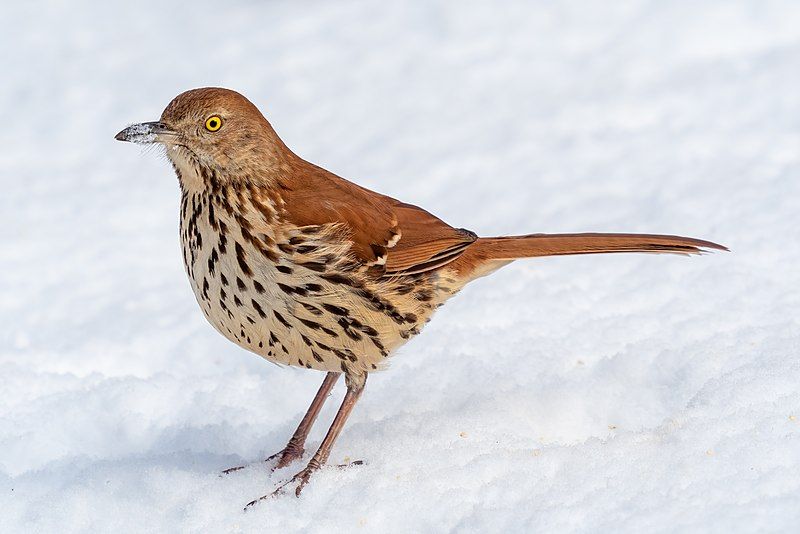
The brown thrasher is a bird that belongs to the family Mimidae. This family includes other birds like the New World catbirds and mockingbirds.
It is important to note that sometimes, people mistakenly refer to the brown thrasher as the brown thrush or fox-colored thrush. The brown thrasher has a distinct appearance with its brown feathers.
Its coloration resembles a fox, sometimes called the fox-colored thrush.
However, it is essential to remember that it is not a thrush but a member of the Mimidae family. As a member of the Mimidae family, the brown thrasher shares similarities with other birds in this group.
Mimidae birds are known for their ability to mimic the sounds and songs of other birds. While the brown thrasher is not as famous for its mimicry skills as mockingbirds, it can still imitate some sounds. The brown thrasher is primarily found in North America.
Its range extends from southern Canada to central Mexico. It prefers habitats such as dense shrubs, woodland edges, and overgrown fields. These areas provide the birds with plenty of cover and food sources. In terms of size, the brown thrasher is medium-sized.
| Kingdom | Animalia |
| Phylum | Chordata |
| Clade | Dinosauria |
| Class | Aves |
| Order | Passeriformes |
| Family | Mimidae |
| Genus | Toxostoma |
| Species | T. rufum |
41. Bewick’s Wren
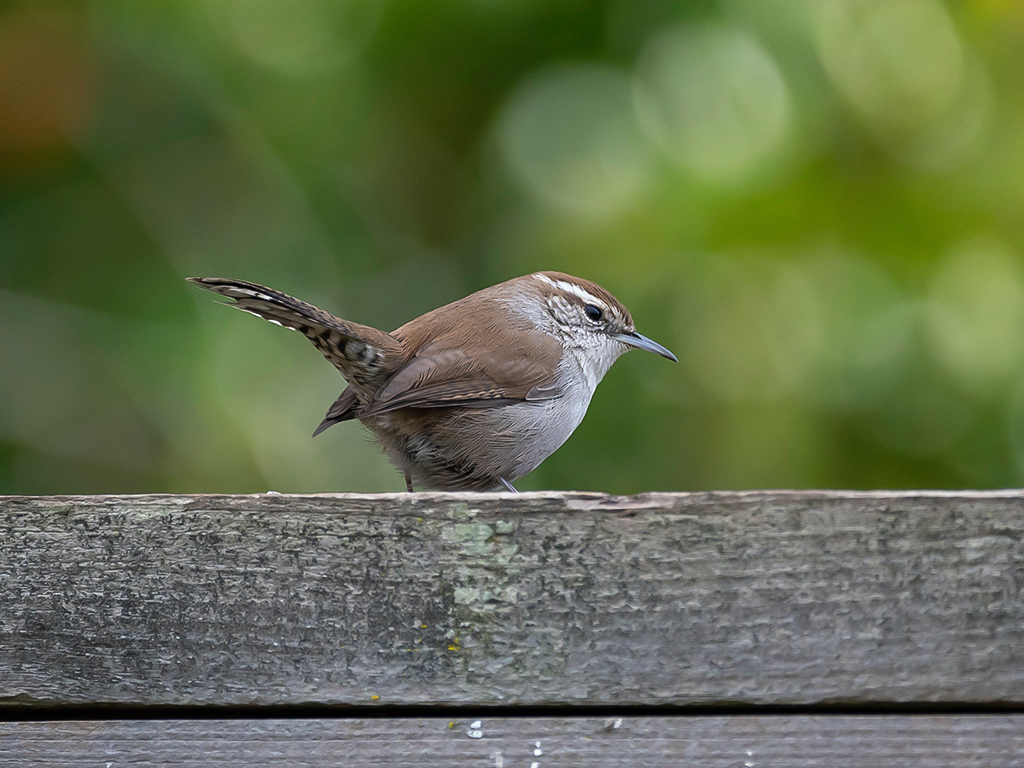
The Bewick’s wren is a type of bird found in North America. It is unique because it is the only species in its genus called Thryomanes. This wren is approximately 14 cm long and has a distinct color pattern.
Its upper body is grey-brown, while its lower body is white. One noticeable feature of the Bewick’s wren is its long white eyebrow. Although the Bewick’s wren may resemble the Carolina wren in appearance, there is one key difference.
The Bewick’s wren has a long tail that is tipped with white. This distinguishing characteristic helps to differentiate it from other wren species. In terms of size, the Bewick’s wren is relatively small, measuring about 14 cm in length.
Its compact size allows it to navigate through various habitats with ease.
The wren’s grey-brown upper body and white underbelly provide effective camouflage, blending in with its surroundings and making it less visible to predators. The Bewick’s wren is known for its melodious song, which it uses to communicate with other wrens and establish its territory.
This bird species is highly vocal and can often be heard singing from perches.
| Kingdom | Animalia |
| Phylum | Chordata |
| Clade | Dinosauria |
| Class | Aves |
| Order | Passeriformes |
| Family | Troglodytidae |
| Genus | Thryomanes |
| Species | T. bewickii |
42. Pine Siskin
The pine siskin is a type of bird found in North America. It belongs to the finch family, which includes other small birds like sparrows and goldfinches.
The pine siskin is known for its ability to migrate, meaning it travels from one place to another depending on the season. During the winter, the pine siskin’s range becomes very unpredictable.
It moves around sporadically instead of following a specific pattern or staying in one place.
Predicting where precisely these birds will be during the winter months can be challenging. The reason behind the pine siskin’s sporadic winter range is not entirely understood.
It is believed that factors like food availability and weather conditions play a role in determining their movements.
When specific food sources become scarce in one area, the birds may move to another location in search of better resources. The pine siskin’s winter range can vary from year to year.
One winter, they might be seen in large numbers in a particular region, while the following winter, they may be scarce or absent from the same area.
This unpredictability adds to the bird’s unique characteristics and makes it an interesting species to study. Researchers and bird enthusiasts often.
| Kingdom | Animalia |
| Phylum | Chordata |
| Clade | Dinosauria |
| Class | Aves |
| Order | Passeriformes |
| Family | Fringillidae |
| Genus | Spinus |
| Species | S. pinus |
43. Northern Harrier
The northern harrier is a bird of prey commonly found in the northern parts of the northern hemisphere. Other names, such as the marsh hawk or ring-tailed hawk, also know it.
This bird is known for its exceptional hunting skills and distinctive appearance. Breeding is a significant part of the northern harrier’s life cycle. It prefers to breed in the regions of the north of Canada and the northernmost parts of the United States.
These areas provide suitable habitats for the bird’s nesting and breeding activities. The northern harrier’s habitat mainly consists of marshes, wetlands, and open fields.
These environments offer an abundance of prey, including small mammals and birds, which the harrier hunts for food.
Its hunting technique is unique as it relies on low, slow flight and uses its keen sense of hearing and sight to locate and capture its prey. One remarkable characteristic of the northern harrier is its distinctive appearance.
It has long, narrow wings allow it to maneuver swiftly through the air. Its tail is also long and distinctive, resembling a ring.
This feature is why it is sometimes referred to as the ring-tailed hawk. The northern harrier is a medium-sized bird, with males usually slightly smaller than females.
| Kingdom | Animalia |
| Phylum | Chordata |
| Clade | Dinosauria |
| Class | Aves |
| Order | Accipitriformes |
| Family | Accipitridae |
| Genus | Circus |
| Species | C. hudsonius |
44. Winter Wren
The winter wren is a tiny bird found in North America. It belongs to the Troglodytidae family, mainly consisting of wrens in the New World.
In the past, it was considered the same species as the Pacific wren in western North America and the Eurasian wren in Eurasia.
However, it is now recognized as a distinct species called the winter wren. The winter wren is known for its small size and is one of the smallest birds in North America.
It can be found in coniferous forests, dominated by cone-bearing trees like pine, spruce, and fir. Its habitat ranges from British Columbia in Canada to the Atlantic Ocean. This little bird is known for its distinctive behavior and appearance.
It has a compact body with short wings and a short tail, making it well-suited for navigating through dense forest vegetation.
Its plumage is usually dark brown with fine streaks on its back and a light-colored throat and belly. During the breeding season, which generally occurs in the spring and summer, the winter wren builds its nest in tree cavities or among tree roots.
The male wren is known for its beautiful and melodious song.
| Kingdom | Animalia |
| Phylum | Chordata |
| Clade | Dinosauria |
| Class | Aves |
| Order | Passeriformes |
| Family | Troglodytidae |
| Genus | Troglodytes |
| Species | T. hiemalis |
45. Sharp-Shinned Hawk
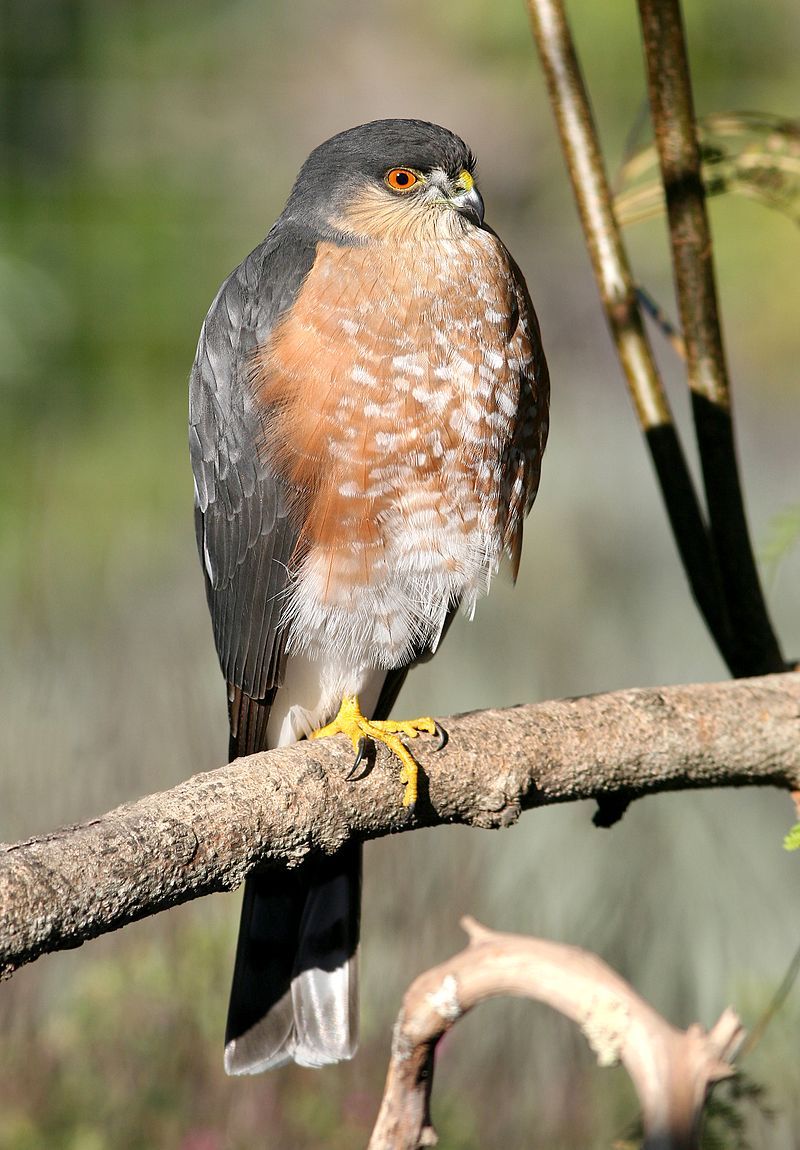
The sharp-shinned hawk, also known as a sharpie, is a small hawk type. The males of this species are the smallest hawks found in both the United States and Canada.
However, it’s worth noting that the sharp-shinned hawk is still larger than certain Neotropical species, such as the tiny hawk. This particular species of hawk is commonly referred to as a sharpie due to its sharp features and small size.
Although it is small compared to other hawks, it is essential to understand that it is still larger than certain types of hawks found in the Neotropics, a region of the Americas encompassing Central and South America.
The sharp-shinned hawk’s size is noteworthy because it is the smallest species in the United States and Canada.
This means that the sharp-shinned hawk stands out for its diminutive size compared to other hawks that inhabit these regions.
Furthermore, it is interesting to consider that despite being small in North American hawks, the sharp-shinned hawk is still more prominent on average than some Neotropical species, such as the tiny hawk.
This suggests that while the sharp-shinned hawk may be small relative to.
| Kingdom | Animalia |
| Phylum | Chordata |
| Clade | Dinosauria |
| Class | Aves |
| Order | Accipitriformes |
| Family | Accipitridae |
| Genus | Accipiter |
| Species | A. striatus |
Conclusion
Winter birds in Arkansas play a vital role in the ecosystem by providing aesthetic beauty and contributing to the balance of the natural world.
These resilient and adaptable creatures brave the cold temperatures and successfully migrate to Arkansas, seeking warmer habitats and abundant food sources.
The state’s diverse landscapes, such as forests, wetlands, and rivers, offer suitable wintering grounds for various bird species.
From the vibrant-colored woodpeckers to the majestic Bald Eagles, winter bird sightings in Arkansas delight bird watchers and nature enthusiasts alike.
However, humans need to recognize the significance of preserving and protecting these habitats to ensure the continued presence of these magnificent winter birds in Arkansas for generations to come.